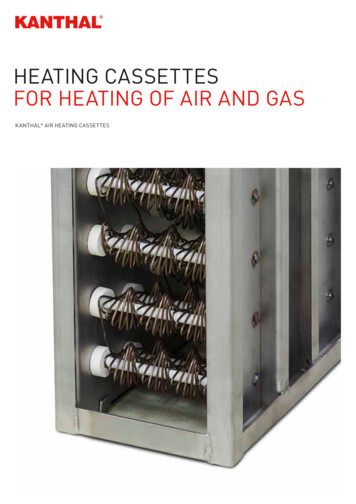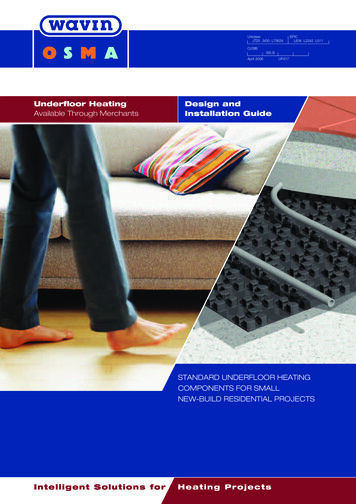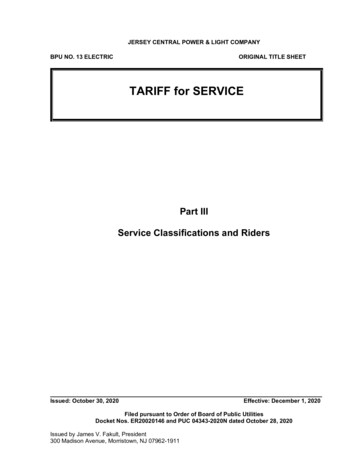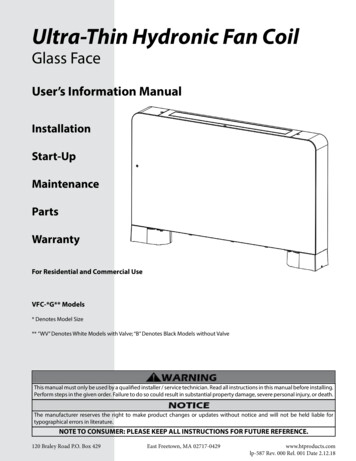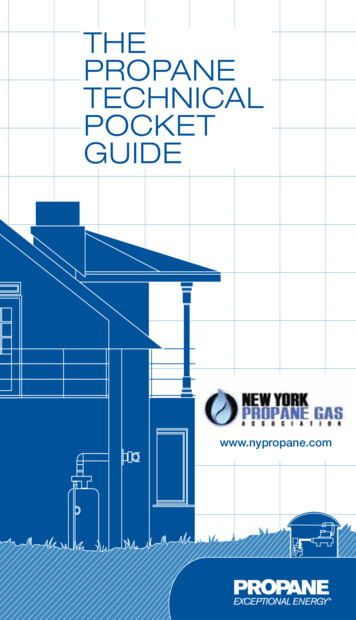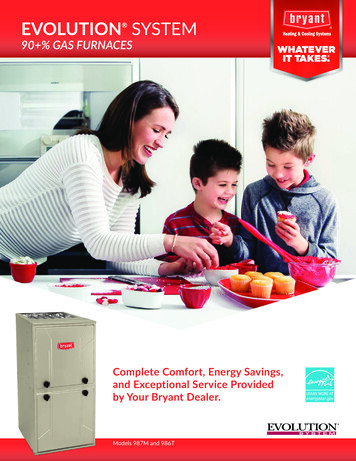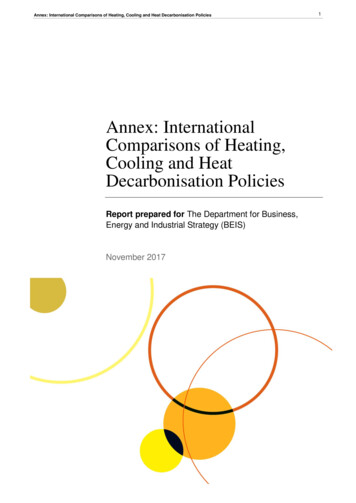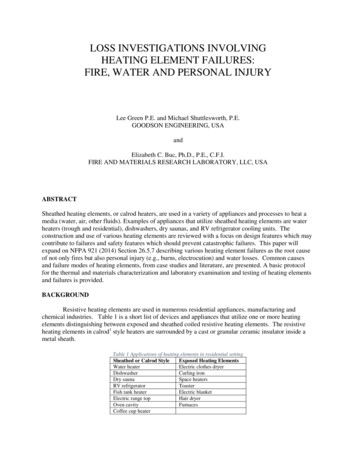
Transcription
LOSS INVESTIGATIONS INVOLVINGHEATING ELEMENT FAILURES:FIRE, WATER AND PERSONAL INJURYLee Green P.E. and Michael Shuttlesworth, P.E.GOODSON ENGINEERING, USAandElizabeth C. Buc, Ph.D., P.E., C.F.I.FIRE AND MATERIALS RESEARCH LABORATORY, LLC, USAABSTRACTSheathed heating elements, or calrod heaters, are used in a variety of appliances and processes to heat amedia (water, air, other fluids). Examples of appliances that utilize sheathed heating elements are waterheaters (trough and residential), dishwashers, dry saunas, and RV refrigerator cooling units. Theconstruction and use of various heating elements are reviewed with a focus on design features which maycontribute to failures and safety features which should prevent catastrophic failures. This paper willexpand on NFPA 921 (2014) Section 26.5.7 describing various heating element failures as the root causeof not only fires but also personal injury (e.g., burns, electrocution) and water losses. Common causesand failure modes of heating elements, from case studies and literature, are presented. A basic protocolfor the thermal and materials characterization and laboratory examination and testing of heating elementsand failures is provided.BACKGROUNDResistive heating elements are used in numerous residential appliances, manufacturing andchemical industries. Table 1 is a short list of devices and appliances that utilize one or more heatingelements distinguishing between exposed and sheathed coiled resistive heating elements. The resistiveheating elements in calrod1 style heaters are surrounded by a cast or granular ceramic insulator inside ametal sheath.Table 1 Applications of heating elements in residential settingSheathed or Calrod StyleExposed Heating ElementsWater heaterElectric clothes dryerDishwasherCurling ironDry saunaSpace heatersRV refrigeratorToasterFish tank heaterElectric blanketElectric range topHair dryerOven cavityFurnacesCoffee cup heater
Refrigerator ice makerSome plug in air freshenersCalrod style heaters are available in a variety of shapes, lengths and watt density; some constructionfeatures, however, are the same. This paper does not address the design of heaters for appliances but thefailure modes and effects of resistive heating elements likely encountered by fire investigators andforensic engineers. Useful source material on the design of heating elements for appliances and processmedia includes various manufacturer’s websites and the book Integrating Electrical Heating Elements inProduct Design.2,3Construction FeaturesA residential appliance heating element works with either 120 volt or 240 volt power. The design ofcalrod style heaters includes an electrical connection from a power cord or supply to a coiled length ofresistive wire between two electrical terminals called cold pins. The resistance of the wire is based on itscomposition, diameter and length. Typical resistive wire alloys are Nichrome (Ni-Cr(Fe) per ASTMB344) or Kanthal (Fe-Cr-Al per ASTM B603). Coiled wires may be single-or dual-wrapped wire. Thecoiled wire is surrounded by an insulating material inside a metallic tube or sheath. Sheath materials canbe ferrous (steel, cast iron, stainless steel, Incoloy, Inconel, etc.) or non-ferrous (aluminum, copper,titanium, quartz, etc.). The insulator serves to keep the wire centered in the sheath to prevent faulting.Due to the higher temperatures of the resistive wire during operation, the insulating material must be ableto withstand temperatures on the order of 600 C and higher depending on the purpose and design of theheating element. Ceramics meet the temperature requirements for sheathed heating elements. Theresistivity of the insulating ceramics must be elevated so that leakage current, and breakdown voltage tothe outside sheathing meets standard IEC 335 Safety Of Household And Similar Electrical Appliances.The insulator, typically magnesium oxide (MgO), may be cast, granular or fine powder. Fused MgO is anindicator of insulator breakdown. Finally, the electrical connections and heater circuit has to be sealed. Asilicon seal or other similar end plug acts as a spacer between the terminal end and the sheath. The plugend design parameters and materials will differ depending upon the use of the heating element, such asopen air or water immersion elements. Figure 1 shows a schematic and photograph of a sheathed heatingelement electrical connection to the coil.Figure 1 Cross section showing cold pin and coiled heating element of calrod style heater (Image on left from Ref. 3).Sheathed heating elements are also found in industrial appliances and process industries and are typicallyreferred to as process heaters, immersion or submersible heaters. Examples include tank heaters tomaintain process solutions, such as electroplating and pickling baths, at an elevated process temperature.In chemical applications, the heater sheath material is selected to resist corrosion by the process media.Some, but not all, sheathed appliance and process heaters have passive or active safety devices. Someprocess heaters have thermal cut off devices inside the heater circuit that will open if overheating occurs.
Sludge legs prevent the heater from sitting on or near the bottom of a tank where sludge could accumulateand cause overheating. If present, safety devices can be by-passed or fail to function.Heating elements can cause fires—acting as an ignition source for a combustible solid during normal use,upset conditions or as a result of catastrophic failure. Based on its surface temperature, heating elementsmay be capable of igniting gases, vapors, mists and particulate or dust. Heating elements can also fail andcause property loss other than fire such as water released from electric water heaters. Electric resistanceheaters are also energized devices and therefore can, under some conditions, result in electrical shock andelectrocution. Burn injuries have also been attributed to the failure of a stove top heating element.Heating elements are the subject of some CPSC product recalls.Not all heating element failures are a fire hazard or cause property damage; a heating element wire thatlocally opens the circuit and the heater then fails to function further is not a fire hazard. The internal faultis contained. If the failure is catastrophic but contained inside a vessel, that is also not combustible, suchas a water tank, a release will not occur. Failures leading to fires, property damage and personal injuryare likely to be encountered by private fire investigators and forensic engineers.NFPA 921 Guide for Fire and Explosion Investigations identifies heaters including calrods as heatproducing devices. The basic construction, operation and failure mode of heating elements are generallydescribed in chapter 26 Appliances and specifically under section 26.5.7 Heating Elements. Due to theirmaterials of construction, heating elements typically survive exposure to an external fire. Heatingelements are also part of an electrical circuit and are subject to arc mapping. Therefore, it is when adamaged heating element is found after a fire, the fire investigator needs to determine how the heaterfailed and if the heater or a failure of the heater was the cause of the fire.Whether or not a fire, water loss or injury occurred, characterizing damage to the subject and exemplarcalrod style heaters is typically occurs during a laboratory examination where the principles and practiceof failure analysis apply.4 The lab exam will typically include a non-destructive and destructivecomponent and should include a close examination of the circuit involving the heating element and allelectrical connections between the receptacle, power cord, safety device, cold pins and coiled resistiveheating element.Another consideration in the investigation of a fire loss is identifying and characterizing fuels in the areaof the heater. Hypothesis testing in demonstrations with exemplar heaters are encouraged. For water lossinvestigations, root cause analyses should include whether the failure is related to installation (e.g., lowliquid level) or manufacturing defect (e.g., at a connection).AT THE LOSS SITEIf available, an investigation of field failures causing fires or water damage benefit from a sitevisit. In addition to photographic documentation and data gathering, the device or appliance and otherslike it should be identified and preserved. In other cases, only the failed heating element is madeavailable for analysis to determine the cause of its failure. In both cases, basic age and use history areimportant.When the site is available, as much of the circuit and subject appliance with the subject heating elementshould be documented in place then preserved for further study in the laboratory. Circuit tracing and arcmapping should be performed. The heating element may be custom built for the process; drawings andorder documentation should be requested. Use history should include the age and last use of the subjectheating element and problems, if any, during operation. Other heating elements, both in use and instorage or stock, should be collected as evidence for comparative analysis and/or incipient stage failures.
For industrial applications, it is important to document and understand the process media and processcontrols. Process data should include the volume to be heated, chemical composition of solution, MSDS,conductivity, temperature, when last cleaned or maintained, etc. Process controls include timers,thermostats, and liquid level controllers. A sample of the process media should be collected.Environmental anomalies including brown-outs or lightning strike data should be gathered.In one case, lightning was alleged to have caused a trough heater to fail electrically. It was shownhowever, that smaller gage, lower melting temperature conductors were more susceptible to damage fromlightning strike than the heating element which exhibited extensive damage at the cold pin. Further, apaper by Miyazaki et al lists home electrical appliances damaged by lightning surges.5 The paper doesnot list heater element appliances and devices in Table 1 as susceptible. In another case, users ofimmersion heaters observed ‘smoking’ from the cap outside the tank where the heater device wasconnected to a power cord. Loose connections were found inside the potting material that decomposedaround the poor connections. One used, heater from the lot collected was energized, decomposed, andfaulted progressing to flaming combustion. Poor wiring connections were identified as accounting for alarge percentage of process heater problems in the field.6LABORATORY EXAMINATION PROTOCOLHeating elements recovered from losses range from intact to fractured or fragmented into one or moresections that may be straight or bent; the separated sections may be large or small. Penetrations in thesheath range from none, to locally damaged to damaged over a length of the heater with melted ormissing metal sheath. The number of openings in the coiled heating wire range from one to many.Faults can occur at one or more location.With the premise of not energizing or operating the subject heating element or device from a loss, ageneral protocol for the laboratory examination of failed sheathed heater elements should including thefollowing steps:1) Understand the operation of the device2) Gross description of circuit and use or appliance3) Photographic documentation including location and type of damage and discoloration4) Examination of sheath surface for manufacturer information, rating and date stamp5) Dimensional measurements6) Electrical measurements at room ambient and other temperatures if thermostatically-controlled7) Radiography and/or computed tomography (CT)8) Cross-section sheath to expose connections and/or coiled heating element9) Examination of damage using microscopy10) Materials characterization by SEM and EDS of sheath, insulator and coiled heating element andany internal damageTable 2 is a summary of data that should be collected during laboratory examination.Table 2 Heating Element Materials Characterization, Electrical Measurements and Dimensional Analysis DataMaterials CharacterizationOuter jacket (if applicable)Sheath materialInsulatorHeating elementMass of all piecesDimensional AnalysisTotal lengthOuter diameterSheath wall thicknessDiameter of coilDiameter of coil wireLength of damageElectrical MeasurementsContinuityResistance at RTResistance at 2nd temp.Hi-Pot
Radiography and/or computed tomography are the most useful non-destructive method that shows aheater’s construction features; the presence, location and condition of safety devices; and, the condition ofthe embedded heating element wire and electrical connections. Radiography will also show if the heatingelement is off-center or near the sheath, the number of coils, coil regularity, and the number and locationof openings in the wire. The density of fused MgO is different from surrounding granular MgO and istypically visible by x-ray or CT images. Figures 2 and 3 are photographs and x-ray images showing asingle and multiple faults and melt locations in titanium sheathed process heater. The heater in Figure 3was collected from the fire’s area of origin. The heater in Figure 2 was found in a collection of discardedheaters from the same plant.Figure 2 Localized breach in sheath of titanium sheathed process heater.Figure 3 X-ray showing multiple physical and wire breaks in a titanium sheathed process heater.SEM/EDS is typically used to determine the composition of the sheath, the insulator and the coiled wire.Once the composition is known, the melting temperature of the sheath can be determined from literature.As part of a fire investigation, exemplar heaters or appliances may be purchased for thermalcharacterization and for use in hypothesis generation and testing. In addition, an exemplar heater mayhave packaging labels, installation instructions, use and care instructions and warning tags. Exemplarheaters can be thermally characterized using thermal imaging and/or thermocouples. Temperatureprofiles should be performed in the same or similar process medium and/or temperature range undernormal and upset conditions. In liquid-based process media, the temperature of the sheath will be loweras heat is transferred from the heater to the media. However, if evaporation occurs (e.g., stuck float,closed make-up water valve, leak in the tank, etc.), the process media may be lost or concentratedcontributing to the failure of the heater. If the heater does not have thermal protection, it can overheat andfault. Other demonstrations could examine if metal splatter and/or hot pieces from a failed sheathedheater can ignite a nearby combustible material. Once a sheathed heater finishes faulting or is fragmentedopen, it will begin to cool. Therefore, the ability for the heater by itself or after failure to ignite nearbycombustibles should be determined by measuring and understanding the operation of the heater, thefailure mode and the type of nearby combustible materials.FAILURE MODES
Failure modes of resistive heating element wires and calrod style heaters may be thermal,chemical, electrical, or mechanical, a combination of two of the listed modes and/or a manufacturingdefect. Calrod heaters have a limited life based on usage and are capable of failing safe. Other calrodheaters fail prematurely and the investigator has to determine if the failure was inherent or precipitated.Common causes of calrod heater failure from numerous sources and field experience are summarized inTable 3.Table 3 Common Causes of Calrod Heater FailuresHeater wire opens with parting arc with or without faulting to sheathHigh temperature corrosionPoor electrical connectionWire deformation leading to locally increased temperaturesLocalized or gross breach in sheathScaling, sludge, coking leading to locally increased temperaturesLoss of heat sinkHeater wires have limited life. Causes of heater wire failure are oxidation, high temperature corrosion,deformation leading to locally increased temperatures and changes in electrical properties.3 Goodson etal published an article on fires caused by fractured resistance heating elements identifying modes offailure as 1) normal over time opening with a parting arc with or without welding to a grounded frame;and 2) improper installation leading to irregular coil length and increased wattage density.7 Magnesiumoxide becomes conductive with increasing temperatures which may occur as a result of localized heatingor faulting. If faulted to the sheath through the insulator, part of the heater circuit can remain energizedby-passing any thermostats or safety devices. From the exterior, oxidation, corrosion product, scaling,‘coking’ and sludge on the sheath can lead to reduced heat transfer, localized over-heating and failure.Overheating, gross or localized, was identified as one of the most common causes of calrod heaterfailures.8 From “Helping Heaters Live Longer”, typical failures of heaters listed are: improper electricalinstallation; low liquid levels; build-up or scaling; chemical misapplication; physical damage andcondensate entering the heater.9 Another website lists premature failures due to corrosion or chemicaldestruction caused by unusual conditions such as excessively high solution temperatures, solutionconcentration, stray electrical currents, excessive sludge build-up, stagnant or turbulent flow of thesolution.10 Manufacturing defects include delamination between a sheath and heat sink (Ref. 8), poorelectrical connections, c sheath resistance weld failures.Calrod style heater failures can occur at different locations: at the electrical connection(s) between thepower cord and cold pin; between the cold pin and wire; at one or more locations within the coil with orwithout faulting to the grounded or ungrounded sheath. Coil bunching leading to increase watt densitiesand temperatures and high resistance connections can occur between the cold pin and heater wireresulting in a failure. Two such failures are illustrated below—one resulted in a breach of the sheath.Figure 4 shows an overview photograph, close up and CT image of a heating element that faulted to thesheath at the cold pin location. A conductive path existed between the wire and sheath but the sheath wasnot penetrated. The black solid analyzed by SEM EDS was found to contain varying concentrations ofiron (Fe) and chromium (Cr) from the heater wire. Figure 5 shows localized damage to a stove heatingelement. The heating element was dual wound and failed due to a high resistance connection at the coldpin connection. The failure resulted in melting and opening of the sheath indicative of the hightemperature fault.
Figure 4 Thermostatically controlled immersion heater failure at cold pin with a conductive path to the sheathFigure 5 Failure of stove top heating element at cold pinA heater element that fails under water or other liquid process media will likely not have sufficient energyto ignite combustibles (e.g., the plastic tank) unless the process media is lost but can become a shockhazard if faulted to the sheath and not properly grounded. While not a fire hazard, an electric water heatercalrod heating element failure can lead to the release of water either through an opening created in thesheath or a melt opening through the screw-plug base (Fig. 6). More often, a failed water heater calroddoes not result in the release of water but a service call and a replacement heating element. Multipleoccurrences of a water heater element failure are likely related to installation. ‘Dry firing’ refers todeformation damage sustained by electric water heater elements when they operate in the absence of orlow water level. The loss of the heat sink can result in overheating until failure. If not installation relatedand the calrod’s sheath is found open along the seam, the sheath weld seam should be examined todetermine if the weld failed first allowing water to intrude and cause the heating element to fail.Figure 6 Failure of water heater element leading to breach in screw plug and release of water.
CASE STUDIESThree field failures are described illustrating causes of and factors contributing to calrod styleheater failures.Fire inside Printed Circuit Board Washer. A business that manufacturers printed circuit boards (PCB)utilized an appliance that resembled a stand-alone modified-dishwasher to wash and rinse productionPCBs of residual flux after soldering. A fire occurred after hours; the washer was the fire’s origin. A Jshaped Incalloy 840 immersion heater was found in the debris at the lower left of the appliance where thewater tank was located. The sheath had two areas of localized damage. It was determined lightningstruck a pole and transformer near the plant resulting in a power surge that interrupted the operation of thewasher and the heating element remained energized ultimately igniting the washer’s plastic water tankthen then faulting. Had the heater failed during normal operation, it likely would not have resulted inignition. The appliance and its calrod heater are shown together in Figure 7.Figure 7 Overview of washer appliance and failed immersion heaterDry Sauna Fire. A fire occurred inside a sports complex men’s locker room dry sauna. The sauna heaterhad three-vertically oriented calrod heaters inside a steel box/housing. The sauna heater was on a timercircuit. Two elements were found electrically damaged and in multiple pieces (Fig. 8); at least one pieceof the calrod heater and some solidified melt were found outside the heater housing. Fuels in theimmediate area at the bottom of the sauna heater were the sauna floor wood slat boards and low densitylight-weight environmental debris accumulated under the boards. Alternate ignition scenarios involvingan operating sauna heater were considered and demonstrations were performed to evaluate whethernewspaper draped over the wood frame surrounding the heater could ignite.
Figure 8 Xray images of dry sauna heater elementsWater Losses from Electric Water Heater Failure. Electric water heaters have one or more calrod styleheating elements. In one case, the electric water heater in the entrance of a seasonal home in Michiganwas found releasing water from the top screw-in heating element location. There was melting in themetal screw flange around the connection to the coil. The leak rate was characterized and the heatingelements removed. In another case, a water leak led to dry firing of the water heater element (Fig. 9). Asa result of dry firing, the exterior sheath was damaged and allowed water into the insulator and creating aconduit for water out of the water heater unit through the interior of the sheathing and out near theexterior electrical connections. The element was a rated for 120V, 2000 Watts.
Figure 9. Dry fire leading to water lossCONCLUSIONThe private or fire investigators and forensic engineers encounter heating elements in the fieldthat can act as ignition sources, cause property damage and personal injury. Site investigations arebeneficial; the subject appliance and its heating element should be preserved for examination in thelaboratory. If damaged, the investigator has to determine how the heater failed and if its failure causedthe loss. At fire losses, nearby and first materials ignited have to be identified. For water losses, theforensic engineer needs to determine why the heater failure and if there are manufacturing or installationcontributing factors.ABOUT THE AUTHORSGoodson Engineering’s Michael Shuttlesworth is a mechanical engineer with 6 years experience in theforensic and failure analysis industry. Mr. Shuttlesworth has a BSME from Oklahoma ChristianUniversity. Mr. Shuttlesworth oversees the mechanical and electrical failure analysis instrumentation andequipment at Goodson Engineering.Goodson Engineering’s Lee Green is a mechanical engineer with 6 years experience in theforensic and failure analysis industry. Mr. Green has a BSME from Oklahoma State, and twoMS degrees in engineering from SMU. He is a licensed engineer in 10 states, and oversees thefirm’s mechanical practice. Mr. Green was formerly a design engineer for PACCAR/Peterbilt.Mr. Green is active in SAE and ASME.FMRL’s Elizabeth Buc is a chemist, metallurgist and fire investigator with 20 years experience in theindustry.ENDNOTES112Calrod is a trademark of GE but is now commonly used to describe a steel sheathed heating element.www.Tempco.com/process heaters.Hegbom, T. (1997). Integrating electrical heating elements in appliance design. New York: MarcelDekker.3
4Technical Council on Forensic Engineering (American Society of Civil Engineers). (1989). Guidelines for failureinvestigation. New York, N.Y: American Society of Civil Engineers.5Miyazaki, T., Ishii, T., Okabe, S.; IEEE Trans. On Electromagnetic Compatibility, 52(4), Nov. 2010, pp.921.6Klein, R., Chemical Engineering, “Immersion Heaters: Selection & Implementation, 113(1), Jan. 2006, pp. 447Goodson, M., Perryman, T., and Colwell, K., Fire and Arson Investigator, Oct. 2002, p. 43.8Murray, S. J., Loud, J. D., and Caligiuri, R. D.; Proc. International Appliance Tech. Conference, 2006.9LeFebvre, F., Products Finishing, 63(2), Nov. 1998, pp. 4210www.process-technology.com M-08-02, Revision Date 00-05/29/08
Sheathed heating elements, or calrod heaters, are used in a variety of appliances and processes to heat a media (water, air, other fluids). Examples of appliances that utilize sheathed heating elements are water heaters (trough and residential), dishwashers, dry saunas, and RV refrigerator cooling units. The
